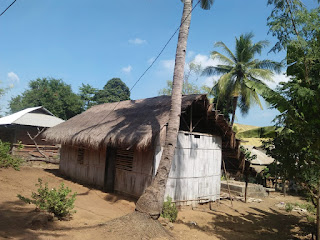By Bernard Liwang, S.PAK
Alor
regency is one of the regencies in East Nusa Tenggara Province. Based on the
geography, the Alor regency is an archipelago consisting of three large islands
(Alor, Pantar, Pura) and six small islands (Buaya, Kangge, Kura, Nuha,
Tereweng, and Ternate islands). Alor Regency has an area of 2.928,88 km2, consisting of 17 districts, including Central
Pantar district. It has ten villages and Delaki village, my home village, is
one of the villages there. Delaki village can be reached by motorboat from the
port of Kalabahi or Small Alor to the
west across the Sawu Sea, routing the southern side of Pantar island through
Tamalabang and Tamakh and travel overland to Alimake.
The profile of Delaki village itself is on the island of Pantar and the western slope of Mount Sirung. The people of Delaki village work as farmers, fishermen, civil servants, teachers, and several other professions. Ten years ago, people used thatched roofs and woven bamboo walls for their houses, but now they have improved to tin roofs and bricked walls with the government aids. Besides the people’s houses, there are other improvements, such as lighting devices that are widely used now from the donated solar cell devices and the state electricity network, walking paths and internet access that is already available even though covers just several areas.
However,
behind this exciting change, there are challenges in this village that have not
changed since the past until now, namely the mindset, way of life of farming,
gardening, fishing, etc. Some of the people in Delaki village have not been
able to accept new changes to be agents of change. They still hold the old
patterns from their ancestors which are considered the best and most trusted
until now. For example, the way of farming, the residents cultivate the farm
traditionally by 'slashing and burning'. In the dry season, they cut down a
patch of forest or their lands about one hectare to be used as
agricultural fields. After being burned, they cultivated the land and grew
several types of plants such as rice, corn, cassava, and other types of plants,
both long-lived and seasonal. The land is then processed traditionally and
manually without any modern tools and supporting tools for planting maintenance
until the harvesting period. Thus an
area of one hectare only produced rice not more than ten sacks with a
quintal per sack, as well as corn and other crops.
Another situation is that the people's crops are consumed to fulfill their food needs for one season and are not for sale because the crops are not enough for them. Besides old mindset of the residents, their inability to make a breakthrough how to process their crops, make villagers are left behind from others. So, it came to a satire as 'a village in a cave', which means a village that never changes. This village has wealth potencies that can be developed, such as cultivating rice fields with an integrated processing system, making various food from fields products, such as chips from corn, cassava, making juice drinks from cucumber, papaya, and other products.
If you pay close attention, the slow development of a village can be affected by the limited young people who have initiative as breakthroughs to bring new insights, knowledge to develop the village and change the mindset, improving the way of life of the people. Alor with unique of each island, its traditional cultures, hand-woven crafts, and accessories, a variety of plantation products to unique views of the hills and the beauty of the underwater panorama of Alor, requires a driving force for development. Do not let the people only be the spectators of the development
The
current demand is that the younger generation, especially those in Alor, who
are well-educated in the modern era should bring changes, have a visioner mindset,
be creative and innovative to become a person who gives benefits.***









Comments
Post a Comment